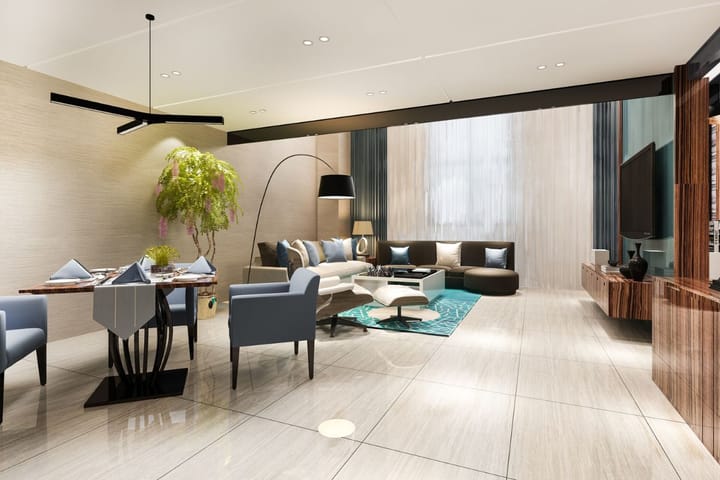The Key Elements To Add To A Functional Home-Office
In a world where the work-from-home culture has been normalized, it is time to build your own little workstation at home!

Nobody would have believed the fact that a large number of people would be working from home a few years ago. Now, the rapid normalization of the work-from-home culture in a lot of companies has led to almost 13% of employees adapting to it completely, while 28.2% of the employees work in a hybrid model. You might not necessarily love your job, but it is still important to consider setting up a home office to be as productive as you can be in an office. Be careful; companies might call you back to the office if they do not see work being done, or worse, fire you. So, we are here to help you with exactly that. Let's see what the fundamental elements are to convert any spare room into a comfortable home office!
Key elements for any home office:
You are one lucky person if your job is completely work-from-home. You can sit in peace in your comfort zone, curling up your feet in any way you want. You can even put your feet on top of your desk, which would typically make your manager complain about your behavior if it was work-from-office. Here are the basic things you should get for you to start crafting your own work-from-home station:
1) Space:
No, don't go thinking about cosmic space. Every house will have one abandoned corner nobody uses. Find that space to make that your work den. Just keep in mind that once you start using this space, you will not be able to make use of it for any other purpose. A spare room or an extra bedroom are the best choices. As long as it is not the basement, you are good to go. You need aesthetics, peace of mind, and more importantly locks to keep toddlers, pets, or any other distractions away. Everyone in your household must know not to interrupt unnecessarily and set a clear boundary between work and leisure.
The room's natural light and ventilation should be as good as it can get. Working in a poorly lit or poorly ventilated room can get you physically and mentally exhausted faster than you can imagine. So, it is wise to choose a room with large windows to let light and air come in naturally. Unless, you're a vampire, of course.
2) Comfy Furniture:
Yes, furniture is expensive. But think about the long-term benefits to your health and overall productivity. Invest in a height-adjustable desk and a chair with good lumbar support. An average employee has to sit for 9-10 hours a day at work and that is not a good number if you decide to use a kitchen chair to support your back. Some lighting is also necessary since some of us might be working through evenings and nights, even though there is natural light during the day. Purchasing table lamps that can illuminate the work desk is a must.
Place your workstation near the windows to utilize them to the maximum. You can occasionally open the windows to let some fresh air circulate and to listen to some birds singing. We feel sorry for you if you have noisy neighbors, though.
3) Gadgets and Connectivity:
There are some gadgets and accessories you might need to get apart from your usual work computer. Since most companies require employees to connect throughout the day on video meets, a good quality web camera and a good microphone can help you in the long run. Next, ensure a proper internet connection in your workstation. Relocating the Wi-Fi modem somewhere closer to your home office can ensure an uninterrupted working experience and you will not have to run out of the room often to check what is wrong with the internet.

Finally, make your desk more convenient by getting a multi-socket extension board for all your chargers and gadgets. Surely, you might already have a power socket next to the desk but you need more sockets when it comes to work. The chances that your laptop and mobile phone might run out of battery at the same time are quite high. Follow a cable management system to organize all these wires and prevent them all from being tangled with each other. The last thing you need after setting up your home office is to be bedridden after tripping on one of the stray wires. Because unfortunately, we do not have a blog to set up a hospital office.
4) Organization and Storage:
If you are a person who tends to just shove all the things into the drawers and shelves, it is high time you might want to invest in a good desk organizer. It can help you organize and sort all the clutter on your desk into categories. Just looking at it will give you a sense of satisfaction, allowing you to work in peace. Not only that, it also will help you find things like an important report or file more quickly since you already know where it is.
When it comes to storage, it is important to declutter your desk once in a while. If you do not have enough storage on your desk, you can mount a shelf not too difficult to reach for your convenience. Categorizing all your work-related documents in terms of frequency of use can greatly help you store away the ones you don't need that often under the bed or somewhere, so you don't trip on them and break your head. No hospital offices, remember?
5) Decorations:
Finally, you might want to personally select a few decor items for your workstation. It can be anything from rugs to plants. The point is to make your home office look pleasant and comfortable to work in. Even if your boss is bombarding you with work, you can at least look at a cute cat figure you have on your desk to make yourself feel good.
Create a positive and enriching workplace by installing artwork, paintings (that you made or purchased), pictures of your favorite trip, fidgeting toys, and anything that can motivate or calm you down. If a picture of your boss pointing a finger at you motivates you, go for it. No judgments.
Conclusion
In conclusion, crafting a functional home office is a multifaceted endeavor that extends beyond just furnishings. It involves the thoughtful integration of various elements to establish an environment conducive to productivity and well-being. By purposefully incorporating these key components into your home office design, you embark on a journey to cultivate a sanctuary that not only supports your professional endeavors but also enriches your overall quality of life.




Comments ()